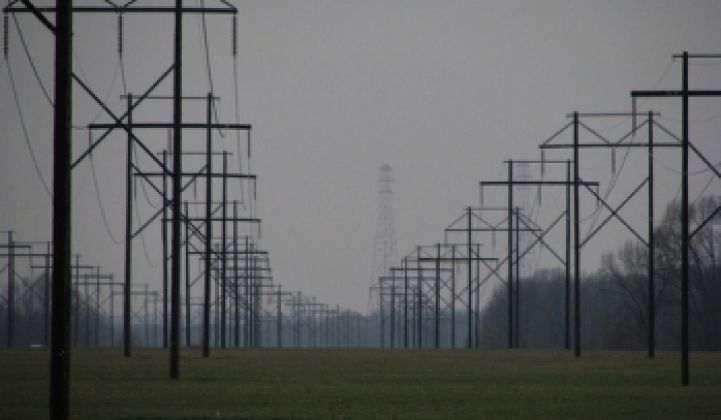The Department of Energy has issued its long-awaited guidelines for utilities and companies hoping to get a piece of the multibillion-dollar smart grid stimulus grant package – and security has emerged as a top concern for projects that want to get funded.
The funding opportunity announcement issued Thursday sets rules for how to apply for about $3.9 billion in grants, which will provide part of the cost of qualifying projects.
It's an important boost for utilities seeking to build out expensive two-way communication and control technologies for their electricity grids, with projects ranging from smart meter networks to sensors and controls for distribution and transmission grids.
As expected, the DOE's funding will be broken into two categories. The larger portion, about $3.3 billion, is for the Smart Grid Investment Grant Program, aimed at technologies that can be deployed on a commercial scale.
And the pressure is on to apply for those investment grants, noted John Quealy, managing director of equity research for Canaccord Adams. Letters of intent are due by July 16, and full applications are due by August 6, with awards to be announced in October, he said.
That means "we'll continue to see a heightened level of news flow by utilities heading into this first deadline," he said.
The grants will also be split up according to the size of the proposed projects, with those under $20 million to get 40 percent of the total, and larger projects between $20 million and $200 million to get 60 percent of the total, he said.
The DOE will also be giving out about $615 million for smart grid demonstration projects, for "new and more cost-effective smart grid equipment, tools, techniques, and system configurations that can significantly improve upon today's technologies." The largest grants it will give under that pool of grant funds is $100 million.
For both types of grants, the DOE has kept to its May decision to increase the maximum grant amounts from what had previously been smaller caps of $20 million for investment grants and $40 million for demonstration grants (see DOE Lifts Smart Grid Stimulus Cap to $200M).
The document goes over the expected guidelines for qualifying projects. They should enable two-way communication and controls to make the grid more efficient and reliable, they should help integrate renewable energy and low-carbon generation into the grid, and of course they should create lots of jobs and economic impact.
The guidelines also make a point of calling for interoperability, or "the capability of two or more networks, systems, devices, applications, or components to share and readily use information securely and effectively with little or no inconvenience to the user."
And then there's security. The vulnerability of smart meter networks to hacking, either by outsiders or disgruntled employees, has become a hot topic in recent months. Some cybersecurity experts say smart meter networks out in the field can be easily hacked in a way that could cause widespread blackouts – claims that are hotly disputed by utility industry groups and smart meter makers (see Hacking the Grid: Is Smarter Less Secure?).
The DOE's announcement makes a point of security when it comes to integrating different systems, stating, "Particular care is required where different networks of varying security levels converge to share information whether it is a utility interface to the home (e.g., smart meters) or a server belonging to a utility or a third-party provider."
The DOE has asked the federal National Institute of Standards and Technology to work with utility group Electric Power Research Institute to come up with more than a hundred standards for smart grid systems. The two delivered their first report on the matter last week.
NIST in May came out with its first 16 proposed standards (see chart here). Those include a security standard for smart meter networks that has been incorporated into the DOE's smart grid grant announcement, George Arnold, NIST's national coordinator for smart grid interoperability, said Thursday at the Edison Electric Institute's annual convention in San Francisco.
"It's a fairly detailed set of regulations... that DOE issued today," Arnold said. "There are requirements having to do with cybersecurity. The issue is going to be ensuring that devices can perform to requirements, and that will require testing and certification."
Just how those new requirements for testing and certification may affect the smart meter deployments and other smart grid projects seeking grant funding will doubtless be a question that utilities and their smart meter technology vendors will be asking as they pore over the DOE's announcement.
Ben Schuman, analyst with Pacific Crest Securities, said that the testing requirement could give a leg up to smart meter makers like Itron, which said last week it was involved in a security testing partnership with the DOE's Idaho National Laboratories (see Smart Meter Security: A Work in Progress).
But then, utilities already have a broad range of security testing that they use to test ongoing smart meter deployments, noted Eric Dresselhuys, vice president of markets for smart grid networking technology maker Silver Spring Networks.
Security testing "is nothing new – it's happening today," Dresselhuys said of Silver Spring's projects to install its networking equipment in smart meters being deployed by Pacific Gas & Electric, Florida Power & Light, American Electric Power and a host of other utilities around the world (see Green Light post).
"We've done well" on those utility security tests, he said, pointing to the fact that Silver Spring's technology is being deployed as proof.
On another standards question having to do with what kinds of communications technologies go into smart grid projects, Arnold said that this is less of a top priority for NIST, and likely for the DOE as well (see Smart Grid: A Matter of Standards).
"Other than security, which is a top concern, there are a lot of lower-tier issues" that can be worked out on a longer timeline, he said.
Image via circulating.



